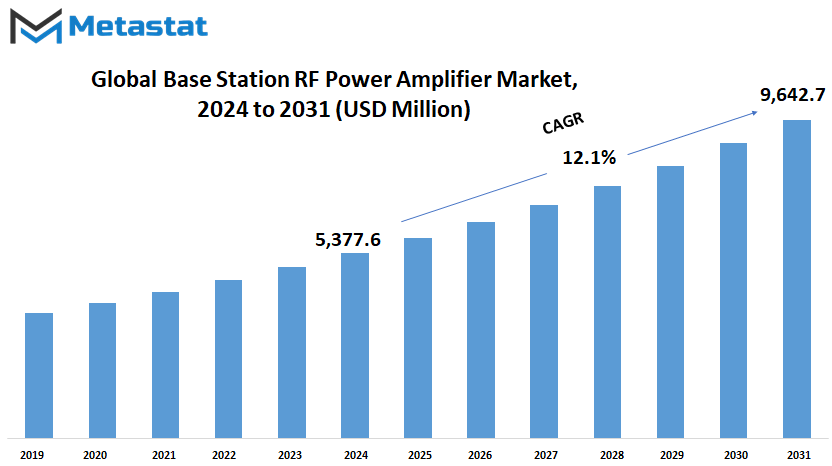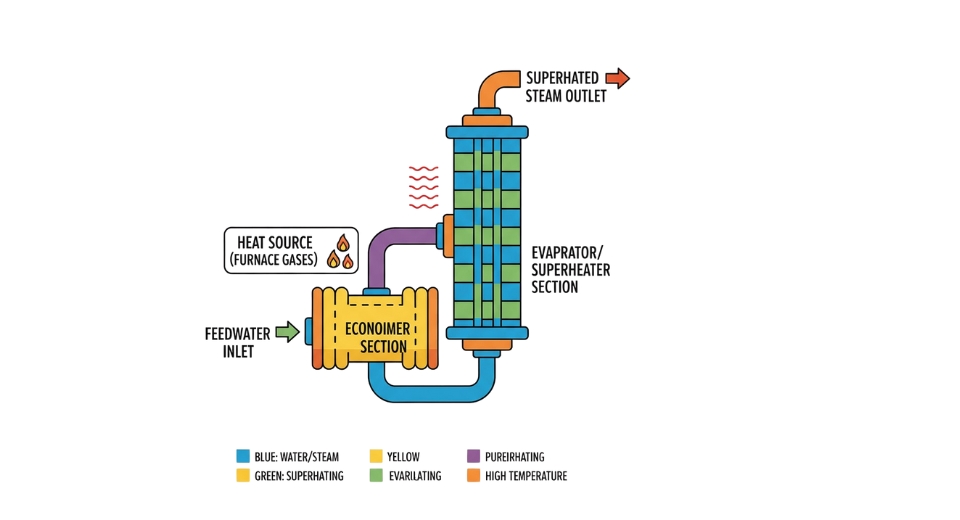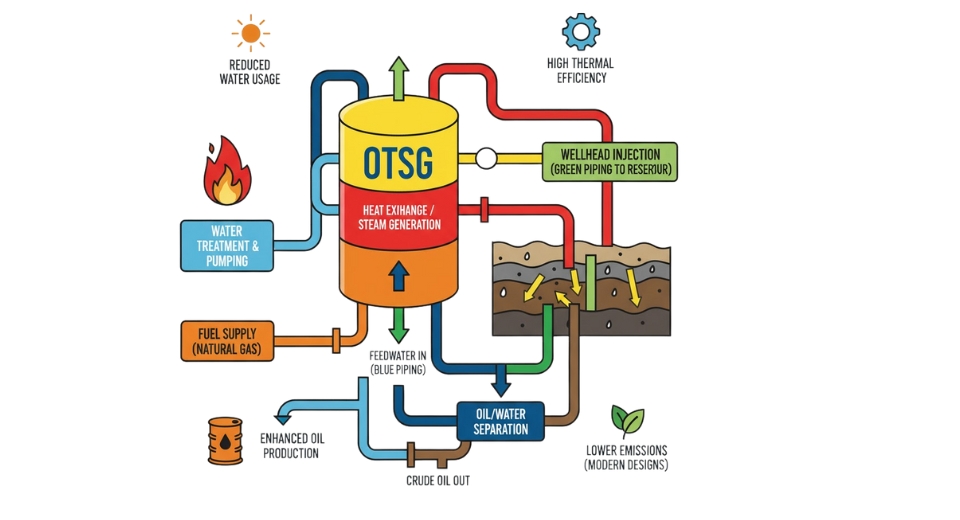MARKET OVERVIEW
The Global Base Station RF Power Amplifier market and its industry are witnessing dynamic shifts and advancements, propelled by the ever-growing demand for seamless connectivity and enhanced network performance. This industry encompasses the production, distribution, and utilization of RF power amplifiers crucial for base stations, serving as the backbone of wireless communication networks worldwide.
In the coming years, the Global Base Station RF Power Amplifier market is anticipated to experience substantial growth, driven by several key factors. Technological innovations and advancements in semiconductor materials and manufacturing processes are expected to result in more efficient and compact RF power amplifiers, catering to the increasing demands for higher data rates and expanded coverage in both urban and rural areas.
Moreover, the proliferation of 5G technology is poised to be a significant driver for the market. With the rollout of 5G networks gaining momentum across the globe, the need for RF power amplifiers capable of supporting the higher frequency bands and enabling ultra-fast data transfer speeds will surge, presenting lucrative opportunities for market players.
Furthermore, the increasing adoption of Internet of Things (IoT) devices and the emergence of smart cities are anticipated to fuel the demand for base station RF power amplifiers. These amplifiers play a crucial role in enabling reliable and low-latency communication between IoT devices and central servers, supporting a wide array of applications, including smart transportation, healthcare, and industrial automation.
Additionally, the escalating demand for mobile data services, driven by the growing penetration of smartphones and tablets, is expected to drive investments in base station infrastructure, thereby boosting the demand for RF power amplifiers. Moreover, the ongoing deployment of small cell networks and the densification of existing cellular networks to address capacity constraints and improve coverage in high-traffic areas will further drive the adoption of RF power amplifiers.
The Global Base Station RF Power Amplifier market is characterized by intense competition and rapid technological advancements. Market players are focusing on research and development activities to introduce innovative products with enhanced performance, efficiency, and reliability. Additionally, strategic collaborations, partnerships, and acquisitions are becoming increasingly common as companies seek to expand their market presence and leverage complementary technologies and expertise.
Looking ahead, the Global Base Station RF Power Amplifier market is poised for significant growth and transformation, driven by the relentless pursuit of improved connectivity, the advent of 5G technology, and the proliferation of IoT devices. As the demand for high-speed, low-latency communication continues to rise, the role of RF power amplifiers in enabling robust wireless networks will become increasingly indispensable, shaping the future landscape of the telecommunications industry.
Global Base Station RF Power Amplifier market is estimated to reach $9,642.7 Million by 2031; growing at a CAGR of 12.1% from 2024 to 2031.

GROWTH FACTORS
In telecommunications, the Global Base Station RF Power Amplifier market is witnessing significant developments driven by various factors. One of the primary drivers is the increasing demand for high-speed data transmission and broader coverage in mobile communication networks. As the world becomes increasingly connected, there is a growing need for networks to handle larger volumes of data quickly and efficiently. This demand is pushing telecommunications companies to invest in upgrading their infrastructure, including base station RF power amplifiers, to meet the needs of consumers.
Furthermore, the deployment of 5G technology is playing a crucial role in shaping the market landscape. 5G technology promises faster data speeds, lower latency, and greater connectivity, but it also requires more advanced and efficient RF power amplifiers to support its infrastructure. This requirement for upgraded equipment is driving the demand for RF power amplifiers in the market.
However, despite these growth opportunities, there are challenges that need to be addressed. One such challenge is the high initial investment and maintenance costs associated with upgrading or deploying new base station equipment. These costs can act as a deterrent for companies looking to invest in expanding their networks.
Additionally, regulatory limitations and spectrum scarcity pose obstacles to the expansion of mobile networks in certain regions. Governments and regulatory bodies play a significant role in allocating spectrum for telecommunications use, and restrictions or limitations can hinder the growth of the market in those areas.
Looking ahead, there are promising opportunities on the horizon for the base station RF power amplifier market. The emergence of technologies like the Internet of Things (IoT) and the development of smart cities are driving the need for enhanced connectivity and coverage. These trends will fuel the demand for base station RF power amplifiers as telecommunications companies work to support the growing network requirements of IoT devices and smart city infrastructure.
While there are challenges facing the Global Base Station RF Power Amplifier market, such as high costs and regulatory constraints, there are also significant growth opportunities driven by increasing demand for high-speed data transmission, the deployment of 5G technology, and the emergence of IoT and smart cities. Adapting to these trends and addressing challenges will be essential for companies operating in this market to thrive in the coming years.
MARKET SEGMENTATION
By Frequency
The Global Base Station RF Power Amplifier market, categorized by Frequency into segments like < 10 GHz, 10-20 GHz, 20-30 GHz, and 30+ GHz, reflects the current landscape of telecommunications infrastructure. This division is pivotal as it allows for tailored solutions to meet the diverse demands of communication networks worldwide.
The frequency spectrum allocation plays a significant role in shaping the market dynamics. Frequencies below 10 GHz, for instance, offer broader coverage but may encounter congestion due to higher usage. On the other hand, the higher frequency bands, like those above 30 GHz, provide higher data rates but have limited coverage due to shorter wavelengths.
In this context, the market's growth trajectory will largely depend on how well manufacturers can address the challenges associated with each frequency band. Strategies aimed at optimizing efficiency, enhancing signal quality, and minimizing interference will be crucial in driving advancements in RF power amplifier technologies across all frequency segments.
Moreover, market players will need to contend with intensifying competition and evolving consumer preferences. As demand for faster, more reliable connectivity continues to rise, manufacturers will face pressure to innovate and differentiate their offerings to stay ahead in the market. This will require ongoing investments in research and development, as well as a deep understanding of customer needs and market trends.
The Global Base Station RF Power Amplifier market, segmented by Frequency, is poised for growth driven by factors such as the adoption of 5G technology and advancements in RF power amplifier technologies. However, market players will need to navigate regulatory challenges and fierce competition to capitalize on the opportunities presented by the evolving telecommunications landscape.
By Material
The Global Base Station RF Power Amplifier market is categorized by Material into Gallium Arsenide, Gallium Nitride, Silicon Germanium, and Others. Each material type will play a crucial role in shaping the future of this market.
Gallium Arsenide, known for its high electron mobility, will continue to be a significant player in the market. Its ability to handle high-frequency signals efficiently makes it ideal for applications where speed and performance are paramount. With the ongoing advancements in semiconductor technology, Gallium Arsenide-based amplifiers will see further improvements, enhancing their reliability and effectiveness in base station setups.
On the other hand, Gallium Nitride is emerging as a promising alternative. Its superior power density and thermal conductivity make it an attractive option for high-power amplification in base stations. As the demand for higher data rates and increased network capacity grows, Gallium Nitride-based amplifiers will gain traction due to their ability to deliver higher efficiency and output power.
Silicon Germanium, with its compatibility with existing silicon-based processes, will continue to find its place in the market. Its integration capabilities with complementary metal-oxide-semiconductor (CMOS) technology make it a cost-effective solution for base station manufacturers. As the industry moves towards smaller form factors and more integrated solutions, Silicon Germanium amplifiers will be vital in meeting the demand for compact and efficient base station designs.
Additionally, the category of Others encompasses various emerging materials and technologies that have the potential to disrupt the market. These may include innovative materials with unique properties that offer benefits such as improved linearity, reduced power consumption, or enhanced reliability. Companies investing in research and development will explore these alternatives to stay ahead of the competition and address evolving market demands.
The choice of material for RF power amplifiers in base stations will significantly impact the performance, cost, and overall competitiveness of telecommunications networks. Manufacturers will need to carefully evaluate the characteristics of each material type and consider factors such as power efficiency, signal integrity, and scalability. Additionally, advancements in material science and semiconductor fabrication processes will continue to drive innovation in this space, leading to the development of more efficient and reliable RF power amplifiers for future base station deployments.
The Global Base Station RF Power Amplifier market's segmentation by Material highlights the diverse range of options available to manufacturers. Each material type brings its own set of advantages and challenges, and their adoption will depend on factors such as application requirements, cost considerations, and technological advancements. As the telecommunications industry continues to evolve, the choice of material will play a critical role in shaping the future of base station infrastructure.
By Application
In the not-so-distant future, technology will continue to advance at a rapid pace, shaping the way we live and interact with the world around us. One area where these advancements will be particularly noticeable is in the realm of communication. As our reliance on wireless devices and networks grows, so too will the demand for efficient and powerful base station RF power amplifiers.
These amplifiers play a crucial role in ensuring that signals transmitted from base stations are strong and clear, allowing for seamless communication between devices. Whether it's a wireless receiver, an audio tape player, a CD player, or a broadcast transmitter, the need for reliable amplification will only increase as our reliance on wireless technology deepens.
One of the key factors driving the growth of the global base station RF power amplifier market is the increasing adoption of wireless technology across various industries. From telecommunications to entertainment, wireless communication has become ubiquitous, and as more devices connect to wireless networks, the demand for robust amplification solutions will continue to rise.
Moreover, as the demand for high-speed data transmission grows, particularly with the advent of 5G technology, there will be a need for amplifiers capable of handling higher frequencies and bandwidths. This will further fuel the growth of the base station RF power amplifier market, as manufacturers race to develop amplifiers that can meet the evolving needs of the wireless industry.
In addition to telecommunications and entertainment, other industries such as healthcare and automotive are also expected to drive demand for base station RF power amplifiers. In healthcare, for example, wireless technology is increasingly being used for remote patient monitoring and telemedicine, creating new opportunities for amplification solutions. Similarly, in the automotive industry, the rise of connected cars and autonomous vehicles will require robust wireless communication systems, driving the need for high-performance amplifiers.
As the global base station RF power amplifier market continues to grow, manufacturers will need to innovate to stay ahead of the competition. This will likely involve the development of amplifiers that are not only more powerful and efficient but also smaller and more energy-efficient. Additionally, with sustainability becoming an increasingly important consideration, there will be a growing demand for amplifiers that consume less power and produce fewer emissions.
The future of the global base station RF power amplifier market looks promising, driven by the increasing adoption of wireless technology across various industries. As demand for reliable amplification solutions continues to grow, manufacturers will need to innovate to meet the evolving needs of the wireless industry, creating new opportunities for growth and advancement.
By End Users
The global Base Station RF Power Amplifier market is set to experience significant growth in the coming years. With advancements in technology and the increasing demand for efficient communication networks, the market will witness a surge in demand from various end users, including Telecommunication, Consumer Electronics, Automotive, Aerospace & Defense, and Medical sectors.
Telecommunication is expected to be one of the primary drivers of growth in the Base Station RF Power Amplifier market. As the world becomes more interconnected, the need for robust and reliable communication infrastructure will continue to rise. Base station RF power amplifiers play a crucial role in enhancing the efficiency and coverage of wireless networks, making them indispensable for telecommunication companies.
Moreover, the Consumer Electronics sector will also contribute significantly to the expansion of the market. With the proliferation of smartphones, tablets, and other wireless devices, there is a growing need for high-performance RF power amplifiers to ensure seamless connectivity and data transmission. As consumer demand for faster internet speeds and better signal quality increases, manufacturers will look to invest in advanced RF power amplification solutions.
In addition to Telecommunication and Consumer Electronics, the Automotive industry will emerge as a key market for Base Station RF Power Amplifiers. With the rise of connected and autonomous vehicles, there will be a growing demand for robust communication systems that can support high-speed data transfer and real-time connectivity. Base station RF power amplifiers will play a crucial role in enabling vehicle-to-vehicle (V2V) and vehicle-to-infrastructure (V2I) communication, enhancing road safety and efficiency.
Furthermore, the Aerospace & Defense sector will also drive the demand for Base Station RF Power Amplifiers. As military and aerospace applications become increasingly reliant on wireless communication technologies, there will be a growing need for rugged and high-performance RF power amplifiers that can operate in harsh environments and withstand extreme conditions. Base station RF power amplifiers will be essential for ensuring secure and reliable communication in mission-critical scenarios.
The Medical sector will also present opportunities for growth in the Base Station RF Power Amplifier market. With the adoption of telemedicine and remote patient monitoring technologies, there will be a growing need for wireless communication systems that can transmit medical data securely and efficiently. Base station RF power amplifiers will play a vital role in supporting these applications, enabling healthcare providers to deliver remote care and monitor patients in real-time.
The global Base Station RF Power Amplifier market will witness significant growth in the coming years, driven by the increasing demand from Telecommunication, Consumer Electronics, Automotive, Aerospace & Defense, and Medical sectors. As technology continues to evolve and connectivity becomes increasingly vital, the market for Base Station RF Power Amplifiers will continue to expand, offering lucrative opportunities for manufacturers and suppliers alike..
REGIONAL ANALYSIS
In analyzing the global Base Station RF Power Amplifier market's regional dynamics, it becomes evident that geographical segmentation plays a pivotal role in understanding market trends and behaviors. The regions under scrutiny include North America, Europe, Asia-Pacific, and others. Each of these regions harbors unique characteristics that shape the market landscape and influence its trajectory.
North America, being one of the pioneering regions in technological advancements, is anticipated to witness substantial growth in the Base Station RF Power Amplifier market. The presence of key market players and a robust infrastructure for telecommunications will propel market expansion in this region. Additionally, the growing demand for high-speed internet and the imminent deployment of 5G networks will further fuel the demand for RF power amplifiers in base stations.
Similarly, Europe, with its focus on innovation and digital transformation, is poised to witness significant market growth. The region's stringent regulations pertaining to telecommunications equipment ensure high-quality standards, thereby fostering market growth. Moreover, the increasing investments in 5G infrastructure development initiatives will drive the adoption of RF power amplifiers in base stations across Europe.
In the Asia-Pacific region, rapid urbanization and the proliferation of mobile devices will be the primary drivers of market growth. Countries like China, Japan, and South Korea are at the forefront of technological innovation and are actively investing in 5G infrastructure. As a result, there will be a surge in demand for RF power amplifiers to support the deployment of 5G networks and enhance network capacity and coverage.
Furthermore, emerging economies in regions such as Latin America and the Middle East and Africa will present lucrative opportunities for market players. The increasing penetration of smartphones and the gradual shift towards digitalization will drive the demand for advanced telecommunications infrastructure, including RF power amplifiers for base stations.
The regional analysis of the global Base Station RF Power Amplifier market underscores the significance of geographical segmentation in understanding market dynamics. While North America, Europe, and Asia-Pacific are expected to dominate the market landscape, emerging economies in other regions will also play a crucial role in driving market growth. As the telecommunications industry continues to evolve, these regional dynamics will continue to shape the trajectory of the Base Station RF Power Amplifier market, presenting both challenges and opportunities for stakeholders.

COMPETITIVE PLAYER
In the forthcoming years, the Global Base Station RF Power Amplifier market will witness a competitive landscape with notable players vying for prominence. Among these competitors are Analog Devices, Broadcom Limited, and Texas Instruments.
These key players are significant contributors to the Base Station RF Power Amplifier industry. Analog Devices, known for its innovative solutions, will continue to play a pivotal role in shaping the market. Similarly, Broadcom Limited, with its extensive portfolio and technological prowess, will exert a considerable influence. Texas Instruments, renowned for its quality products and market presence, will also be a formidable competitor in the arena.
Analog Devices, Broadcom Limited, and Texas Instruments will each bring unique strengths to the table. Analog Devices, with its focus on cutting-edge technology and customer-centric approach, will strive to deliver superior performance amplifiers tailored to meet evolving market demands. Meanwhile, Broadcom Limited, leveraging its diverse product range and strategic partnerships, will aim to capture a larger market share by catering to a wide spectrum of consumer needs. Texas Instruments, with its reputation for reliability and innovation, will continue to innovate and adapt to emerging trends, ensuring its relevance in the competitive landscape.
In the future, these competitive players will engage in various strategies to maintain their positions and gain a competitive edge. This may involve continuous research and development efforts to introduce new and improved products that address the evolving requirements of the market. Additionally, strategic collaborations and partnerships may be pursued to expand market reach and enhance technological capabilities.
Furthermore, factors such as technological advancements, changing consumer preferences, and regulatory developments will shape the competitive dynamics of the Base Station RF Power Amplifier market. Players will need to remain agile and responsive to these external influences to stay ahead of the competition.
The Global Base Station RF Power Amplifier market will witness fierce competition among key players such as Analog Devices, Broadcom Limited, and Texas Instruments. These companies will leverage their strengths and adopt innovative strategies to thrive in an increasingly competitive landscape. With continuous innovation and adaptation to market dynamics, they will play a crucial role in driving the growth and evolution of the Base Station RF Power Amplifier industry in the years to come.
Base Station RF Power Amplifier Market Key Segments:
By Frequency
- < 10 GHz
- 10-20 GHz
- 20-30 GHz
- 30+ GHz
By Material
- Gallium Arsenide
- Gallium Nitride
- Silicon Germanium
- Others
By Application
- Wireless Receivers
- Audio Tape Players
- CD Players
- Broadcast Transmitters
- Wireless Transmitters
- High Audio System
By End Users
- Telecommunication
- Consumer Electronics
- Automotive
- Aerospace & Defense
- Medical
Key Global Base Station RF Power Amplifier Industry Players
- Analog Devices
- Broadcom Limited
- Texas Instruments
- Infineon Technologies
- Maxim Integrated
- Qorvo
- NXP
- Ampleon
- Sumitomo
- UMS
- MACOM Technology
- Analogic Corporation
- BONN Elektronik GmbH
- CML Microsystems Plc
- ETL Systems Ltd
WHAT REPORT PROVIDES
- Full in-depth analysis of the parent Industry
- Important changes in market and its dynamics
- Segmentation details of the market
- Former, on-going, and projected market analysis in terms of volume and value
- Assessment of niche industry developments
- Market share analysis
- Key strategies of major players
- Emerging segments and regional growth potential








 US: +1 3023308252
US: +1 3023308252






